Bracken on the Wolds
Bracken on the Wolds (or Bracken) is a manor and hamlet in the East Riding of Yorkshire, England. It is situated in the Yorkshire Wolds approximately 1 mile (2 km) north-west of Kilnwick and 2 miles (3 km) north-east of Middleton on the Wolds. It lies less than 1 mile (2 km) east of the A614 road.
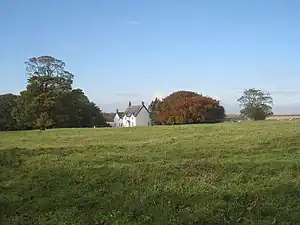
| Bracken on the Wolds | |
|---|---|
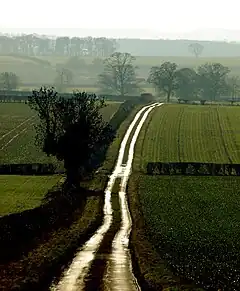 The minor road through Bracken | |
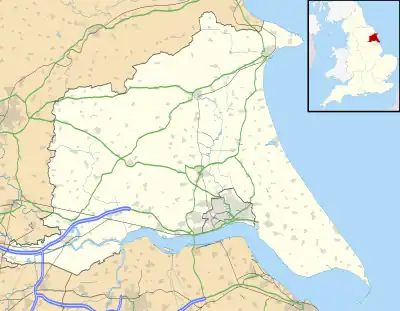 Bracken on the Wolds Location within the East Riding of Yorkshire | |
| OS grid reference | SE982508 |
| • London | 166 mi (267 km) S |
| Civil parish | |
| Unitary authority | |
| Ceremonial county | |
| Region | |
| Country | England |
| Sovereign state | United Kingdom |
| Post town | DRIFFIELD |
| Postcode district | YO25 |
| Dialling code | 01377 |
| Police | Humberside |
| Fire | Humberside |
| Ambulance | Yorkshire |
| UK Parliament | |
The manor forms part of the civil parish of Watton. It was formerly a village of greater size with a chapel and graveyard.[1][2] Since the 19th century, it has consisted of several rural estates - namely Horn Hill Farm, Bracken Fold, Bracken Farm and Bracken Burrows.[3]
.jpg.webp)
There are woodlands, walking paths, manorial waste and two streams that lie within its boundary - Bracken Beck in the south and an unnamed tributary of Cawkeld Sinks (a small lake in nearby Kilnwick) in the east. A portion of the Minster Way crosses through the manor centre, from the south-east near Wedding Wood in Kilnwick to its northern boundary.
.jpg.webp)
Etymology
Bracken (historically spelt Bracenan, Brachen, Braken or Brackyn) is believed to derive its name from an abundance of the fern found there, which was cleared to form the settlement.
The name is of North Germanic origin, from Old Norse *brakni “undergrowth”, related to Proto-Germanic *brekaną and ultimately from Proto-Indo-European *bʰreg- "to break". Cognates include Danish and Norwegian bregne, as well as Swedish bräken "fern."
The name Wold is derived from the Old English wald meaning "forest", a cognate of German Wald, but unrelated to English wood, which has a different origin.[4] Wold is an Anglian form of the word, as in other parts of England, different variations can be found.[5]
Over the years the meaning changed from "forest" to "high forest land". When the forests were cleared, the name was retained and applied to upland areas in general. This was particularly true in the Cotswolds, the Lincolnshire Wolds and also the Yorkshire Wolds.[4]
History
Viking and Anglo-Saxon England
The settlement of Bracken likely originated during Viking Age Britain, however it may date to an earlier period. At the time of the Earldom of York in 972 the Anglo-Scandinavian estate was recorded as "Bracenan"[6] in a memorandum on the estates of the See of York by the Benedictine Archbishop, St. Oswald of Worcester, which reads: " . . . þreo hida æt Bracenan he gebohte æt Eadgare cinge . . . " The estate was owned by the Archbishopric in place of a thegn and measured to be 3 hides. It was noted to have been bought by a previous Archbishop of York, Oscytel, from King Edgar the Peaceful.[7] This would have occurred between 959 and 971, immediately after Viking rule in the Danelaw had ended - when Eric Bloodaxe was driven out of Northumbria in 954.
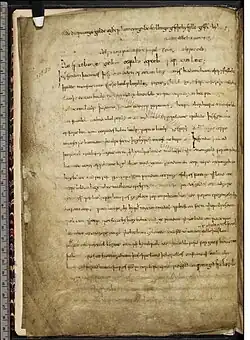
In the memorandum St. Oswald further stated:
I, Archbishop Oswald, declare that all these lands which Archbishop Oscetel obtained in Northumbria, and which my lord granted me for St. Peter's when he was at Nottingham, together with these other lands which are entered here besides, I had them all until [unintelligible] ascended. Then St. Peter was robbed of them. May God avenge it as He will.[8]
This narrowly preceded the "manifold disturbances" or anti-monastic reaction, during the reign of King Edward the Martyr, mentioned in the Anglo-Saxon Chronicle.[9] During this time, many of King Edgar's former grants to monasteries were undone and the lands were distributed amongst the local nobility.
The era between the ensuing North Sea Empire and the Norman Invasion were tumultuous and account of the estate is obscured.
Norman England
In the years following the Norman Conquest in 1066, all manors in England were seized by William the Conqueror and the majority were subsequently granted to his nobles. In Northern England, William encountered great resistance to his rule, which he dealt with ruthlessly.
The winter of 1069–1070 saw the Harrying of the North and the razing of the historic county of Yorkshire. It is unknown if Bracken was among the areas directly affected by the scorched earth tactics employed by the King's men, however by the next written account it was under Norman control.
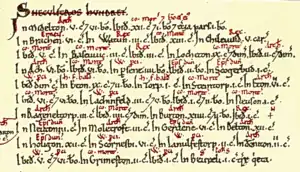
The manor was listed as "Brachen"[10] within the Domesday Book in 1086, where it is recorded in the Hundred of Sneculfcros as: "In Brachen. Erneiſ. vi. c𛰁." The land was surveyed to be 6 carucates, equivalent to approximately 720 acres.
Erneis is presumed to be Erneis de Buron, Lord of Hunsingore and High Sheriff of Yorkshire.[11] He was a feudal baron who had fought at the Battle of Hastings, under the banner of Odo of Bayeux. He is named in both the Falaise Roll and in the Rolls of Battle Abbey.[12] He had settled in England by 1068 and held a number of other manors in Yorkshire and Lincolnshire as Tenant-in-chief before having them confiscated by King Henry I between 1102 to 1118.
By 1118 the majority of the former estates of Erneis de Buron had been granted to Geoffrey FitzPayne Trussebut, who later founded the Augustinian Warter Priory in 1132. After Geoffrey's death, his lands were initially seized for a period of time by King Stephen of Blois and many of his lands were granted to Ranulf de Gernon, 4th Earl of Chester around 1142.[13] The lands were eventually returned to Geoffrey's grandson, William Trussebut the Younger, Lord of Warter and were afterwards known as the Trussebut Fee. His eldest son, Geoffrey, and second son, Robert, each held the manor successively - both dying without issue. The Trussebut Fee was then partitioned between their three sisters Rohese, Hilary and Agatha in 1194.[14]
A Yorkshire charter of 1194 recorded the manor as a Knight's fee allotted to Agatha Trussebut.[15] She was married to William d'Aubigny, Lord of Belvoir, one of the senior Sureties of the Magna Carta of King John I. When Agatha died in 1247, lordship of Bracken passed to her daughter, Isabel d'Aubigny, who had married Sir Robert de Ros, Lord of Helmsley, the great-grandson of William the Lion, King of Scots. De Ros, whose forebear had assumed the arms of Trussebut of Warter, further inherited the entirety of the Trussebut Fee through his marriage to Isabel.[16] Due in part to his grandfather's membership in the Order, Sir Robert remained a principal benefactor to the Knights Templar throughout his life - allowing the Order to benefit from a number of his manors.
Late Middle Ages
A collection at Berkeley Castle Archives provides the descent of the manor in the 13th & 14th centuries, recounted below:
"The manor was acquired by Samson Foliot in 1271-2 except for a holding of a croft and 2 bovates of land which was sold separately to him. When forfeited by the Contrariant Henry Lord Tyeys it was granted to Geoffrey le Scrope in May 1322 (at first for life but then to him and his heirs in July), and probably remained in his hands until Feb. 1329 when he was granted an Exchequer annuity in its place. It then passed to Tyeys's sister Alice and was inherited by her son Gerard de Lisle on her death in 1347. In 1350 Gerard exonerated the sheriff of Yorkshire for profits of the manor taken by the sheriff since Alice's death, and he held it at his death in 1360. It was granted to his widow Elizabeth (d. 1362) in dower, with half of the manors of Kingston Lisle and Fawler, in exchange for those of Mundford, Fritwell and Lydiard Tregoze, which had originally been assigned to her. Warin was described as lord of Bracken in 1364."[17]
A 1415 Knight's fee in Bracken was held by the widow of Roger Scrope, 2nd Baron Scrope of Bolton[18] and an enfeoffment of 1439 records John, Lord de Scrope.[19]
Tudor to Stuart period
Later in 1535 John Scrope, 8th Baron Scrope of Bolton was noted to have collected rental for Bracken.[20] The manor was held by the Barons of Bolton until the death of Emanuel Scrope, 1st Earl of Sunderland and 11th Baron of Bolton, who had been raised to the Earldom of Sunderland in 1627. After his death in 1630, his eldest daughter Mary inherited Bracken. She later married Charles Paulet, 1st Duke of Bolton, at the time 6th Marquess of Winchester, in 1655. The manor passed in 1699 to their daughter Jane, who married John Egerton, 3rd Earl of Bridgewater.
Georgian to Victorian era
Accounts of the Bridgewater Estate in 1748 note rent being taken in Bracken, presumably for John Egerton, Bishop of Durham.[21] His daughter, Amelia Egerton, Lady Hume, inherited the manor following his death in 1787. In 1798 Sir Abraham Hume, 2nd Baronet and Amelia had the estate of Bracken surveyed by Ralph Burton. It was found to contain 660 acres, 2 roods and 17 perches of demesne land.[22]
The seventh edition of A Topographical Dictionary of England, by Samuel Lewis, describes the manor in the late 1850s as:
"BRACKEN, a township, in the chapelry of Kilnwick, union of Driffield, Bainton-Beacon division of the wapentake of Harthill; E. riding of York, 6¾ miles (S. W. by S.) from Driffield; containing 33 inhabitants. It is on the road from Beverley to Malton, and comprises about 600 acres. The village was formerly populous; and contained a chapel, the cemetery belonging to which remains undisturbed."[2]
As part of the estate of John Egerton, Viscount Alford, the manor passed to his eldest son John Egerton-Cust, 2nd Earl Brownlow in 1863. It then passed to the second son Adelbert Brownlow-Cust, 3rd Earl Brownlow when he succeeded in the Earldom of Brownlow and Viscountcy of Alford on the death of his elder brother in 1867.
In 1894-95 the manor was recorded in The Comprehensive Gazetteer of England & Wales:
"Bracken, a hamlet and a township in Kilnwick parish, in the E.R. Yorkshire, 6 miles SW by S of Great Driffield. Acreage of township, 677; population, 25."[23]
Present day
Lord Brownlow died without heirs in 1921 with the earldom and viscountcy becoming extinct. An indenture in 1923 recorded the transfer of the manor to the Rev. Dr. Robert Edleston, Baron de Montalbo.[24] The Law of Property Act of 1925 abolished copyhold throughout the United Kingdom by converting existing tenures to freehold and effectively separating them from the lordship. In 1953 the lordship was inherited by Edleston's sister, Sarah Edleston. In 1969 it was vested in the Hanby Holmes family who held the title, demesne land and manorial rights until they were later passed by deed of conveyance to the current owners in 2023, just prior to the coronation of King Charles III.[25]
Lordship
The feudal lordship title is held by Charles and Nora Grierson, 40th Lord and Lady of Bracken.[25] The manorial land and rights remain appendant to the title.[26]
 Arms of the current Lord of Bracken
Arms of the current Lord of Bracken
Descent of the lordship
| Order | Name | Title | Arms | Years held | Notes |
|---|---|---|---|---|---|
| I | Edgar the Peaceful | King of England | after 959 | ||
| II | Oscytel | Archbishop of York | after 959-971 | ||
| III | Edwald | Archbishop of York | 971 | ||
| IV | Saint Oswald of Worcester | Archbishop of York, canonised | 971-972 | Estate surrendered to an unknown noble | |
| V | William of Normandy | King of England | 1066-before 1086 | Seized English lands | |
| 1st | Erneis de Buron | Lord of Hunsingore | before 1086-1106 | Granted by the crown | |
| 2nd | Hugh de Buron | Lord of Hunsingore | 1106-c1118 | ||
| 3rd | Geoffrey FitzPayne Trussebut | Lord of Warter | c1118-c1139 | ||
| 4th | Stephen of Blois | King of England | c1139-c1142 | Manor reverted to the crown | |
| 5th | Ranulf de Gernon | 4th Earl of Chester | c1142-1153 | Granted by the crown | |
| 6th | William Trussebut the Younger | Lord of Warter | c1154-1175 | Established inheritance of the manor | |
| 7th | Geoffrey Trussebut | Lord of Warter | 1175-1190 | ||
| 8th | Robert Trussebut | Lord of Warter | 1190-1193 | ||
| 9th | Agatha d'Aubigny née Trussebut & William d'Aubigny | Lord & Lady of Belvoir | 1193-1247 | ||
| 10th | Isabel de Ros née d'Aubigny & Sir Robert de Ros | Lady of Belvoir & Lord of Helmsley | 1247-1271 | ||
| 11th | Sir Samson Foliot | Lord of Chilton Foliot | 1271-c1282 | ||
| 12th | Henry le Tyeys | 1st Baron Tyeys | c1282-1307 | ||
| 13th | Henry le Tyeys | 2nd Baron Tyeys | 1307-1322 | Lands forfeited, executed | |
| 14th | Sir Geoffrey le Scrope | Lord Chief Justice of England | 1322-1329 | Granted by the crown | |
| 15th | Alice de Lisle née le Tyeys & Sir Warin de Lisle | 3rd Baroness Tyeys & Keeper of Windsor Castle | 1329-1347 | ||
| 16th | Gerard & Elizabeth de Lisle | 1st Baron & Baroness Lisle | 1347-1362 | ||
| 17th | Warin de Lisle | 2nd Baron Lisle | 1362-1382 | ||
| 18th | Richard Scrope | 1st Baron Scrope of Bolton | 1382-1403 | ||
| 19th | Roger Scrope | 2nd Baron Scrope of Bolton | 1403 | ||
| 20th | Richard Scrope | 3rd Baron Scrope of Bolton | 1403-1420 | Lands in the keeping of Queen Catherine of Valois until coming of age | |
| 21st | Henry Scrope | 4th Baron Scrope of Bolton | 1420-1459 | Lands in the keeping of Richard Neville, 5th Earl of Salisbury until coming of age | |
| 22nd | John Scrope | 5th Baron Scrope of Bolton | 1459-1498 | ||
| 23rd | Henry Scrope | 6th Baron Scrope of Bolton | 1498-1506 | ||
| 24th | Henry Scrope | 7th Baron Scrope of Bolton | 1506-1533 | ||
| 25th | John Scrope | 8th Baron Scrope of Bolton | 1533-1549 | ||
| 26th | Henry Scrope | 9th Baron Scrope of Bolton | 1549-1592 | ||
| 27th | Thomas Scrope | 10th Baron Scrope of Bolton | 1592-1609 | ||
| 28th | Emanuel Scrope | 1st Earl of Sunderland | 1609-1630 | ||
| 29th | Mary Paulet née Scrope & Charles Paulet | Marchioness of Winchester & 1st Duke of Bolton | 1630-1699 | ||
| 30th | Jane Egerton née Paulet & John Egerton | 3rd Countess & Earl of Bridgewater | 1699-1716 | ||
| 31st | Henry Egerton | Bishop of Hereford | 1716-1746 | ||
| 32nd | John Egerton | Bishop of Durham | 1746-1787 | ||
| 33rd | Lady Amelia Hume née Egerton & Sir Abraham Hume, Bt. | 2nd Hume Baronet of Wormleybury | 1787-1838 | ||
| 34th | Sophia Cust née Hume & John Cust | Baroness & 1st Earl Brownlow | 1838-1853 | ||
| 35th | John Egerton-Cust | 2nd Earl Brownlow | 1853-1867 | ||
| 36th | Adelbert Brownlow-Cust | 3rd Earl Brownlow | 1867-1921 | Held by trust until 1923 | |
| 37th | Robert Edleston | Baron de Montalbo | 1923-1952 | Held in estate until 1953 | |
| 38th | Sarah Edleston | Lady of Buckden | 1953-1956 | Held by executors until 1969 | |
| 39th | Richard & Olivia Hanby Holmes | Lord & Lady of Chesterton | 1969-2023 | ||
| 40th | Charles & Nora Grierson | Lord & Lady of Bracken | 2023-present |
See also
References
- "The National Gazetteer: A Topographical Dictionary of the British Islands, Compiled from the Latest and Best Sources, and Illustrated with a Complete County Atlas, and Numerous Maps (1868)". United Kingdom: Virtue. 1868. Retrieved 7 June 2023.
- "Bracken". UK Genealogy Archives. Retrieved 13 August 2023.
- "Census of England and Wales. (43 & 44 Vict. C. 37.) 1881.... (1883)". United Kingdom: Eyre and Spottiswoode. 1883. Retrieved 8 June 2023.
- Gelling. pp. 222–227
- Oxford Dictionary of English Etymology, edited by C. T. Onions, Oxford, 1966. p. 1011
- "S 1453". Early Medieval England. Retrieved 8 June 2023.
- "Source: Charter S1453". The Prosopography of Anglo-Saxon England. Retrieved 8 June 2023.
- "The Monastic Revival of Tenth-Century England". Orthodox Christian Books. Retrieved 8 July 2023.
- Swanton, Anglo-Saxon Chronicle, p. 121, Ms. D & E, s.a. 975 & p. 122, Ms. C, s.a. 976.
- "Yorkshire: East Riding A-G". The Domesday Book Online. Retrieved 16 May 2023.
- Hale, Henry S. (1874). The Norman People. And Their Existing Descendants in the British Dominions and the United States of America. London: Henry S. King & Co. page 108 The Norman People Archive Org. Accessed 2013-6-8
- Battle of Hastings Abbey and Battlefield English-Heritage Org. Retrieved 2013-6-7
- Early Yorkshire Charters Volume 10, Farrer and Clay 1955, p. 4
- "Mediaeval Families: Trussebut". The Boddy Family. Retrieved 16 June 2023.
- Early Yorkshire Charters, Farrer and Clay 1955, p. 104
- History and Directory of East Yorkshire, T. Bulmer, 1892.
- Yorkshire: BCM/B/3/9 Bracken Berkeley Castle Muniments
- Early Yorkshire Charters Ed. Farrer and Clay 1955 p. 106
- CR 26/1/11/K26 Warwickshire Record Office
- "Account roll of John Scrope 8th Baron of Bolton" North Yorkshire Record Office
- AH 1197 Hertfordshire Record Office
- AH 1859-1872 Hertfordshire Record Office
- "Bracken, East Riding of Yorkshire". UK Genealogy Archives. Retrieved 13 August 2023.
- Vol. 385, Pg. 488, No. 173 Northallerton Record Office
- Issue 64054, pg. 9742 Other Notices The London Gazette
- Notice 4354320 The London Gazette